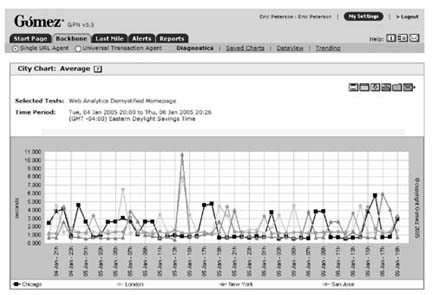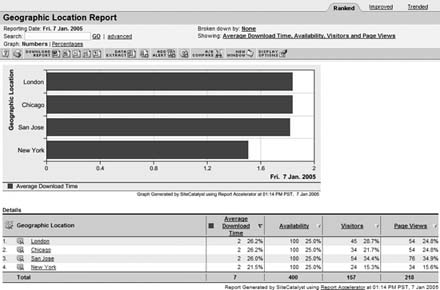Hack68.Measure Site Performance
Hack 68. Measure Site Performance
Combining site performance and visitation data can provide valuable insight into visitor behavior. Because it is so critical to a visitor's perception of one's site, web site performance has been discussed at great length by a multitude of authors. For example, Web Performance Tuning by Patrick Killelea (O'Reilly) is an excellent resource for this information. In this hack, I discuss site performance in the context of web site measurement. If you're interested in a more complete treatment, I encourage you to grab a copy of Patrick's book. The elements of site performance you need to know in the context of web measurement are the basics of performance measurement and how performance and visitation data can be meaningfully combined in a "one plus one equals three" data integration model. 5.2.1. Web Performance Measurement: The BasicsWeb performance management applications measure response time and availability. Response time, or the amount of time a page or process [Hack #69] takes to load, is usually measured from a variety of geographic locations and ideally over both modem and broadband connections. Usually what you end up with is a report similar to Figure 5-1. The essence of these reports is the average, maximum, and minimum response times and corresponding availability from as many geographic locations as you wish to test (read: "pay for"). The nice thing performance measurement vendors do, at least regarding web site measurement, is provide this data in easily transformed spreadsheets suitable for import into your web measurement application. Figure 5-1. Site performance report 5.2.2. Integrating Performance and Visitor Data MeaningfullyProvided that your web measurement application has the ability to import data from external sources, you may be able to build a side-by-side comparison of your traffic and site performance data (Figure 5-2). There are three basic strategies you may want to consider for combining these types of data, depending on your measurement application's abilities and your particular data needs. 5.2.2.1 Basic aggregate performance and availability integration.The simplest model involves doing little more than importing the average download time and availability for all measured locations and reporting side by side with relevant traffic metrics. While this is the easiest integration possible, it is also the least interesting, not providing minimum or maximum response times or geographically based measurements. 5.2.2.2 Detailed performance and availability integration.A slightly more complex model involves importing the minimum, maximum, and average response times for your aggregate performance measurement. This data, visualized with basic traffic data, will help you better understand whether there were any significant performance events during the time period (identified by high maximum response times). Figure 5-2. Geographically correlated performance and availability 5.2.2.3 Geographically correlated performance and availability integration.If you're really motivated and you're using a flexible enough web measurement application, you can geographically correlate your performance and traffic data. In this view, you're able to see your performance and availability data, measured from specific geographic regions, correlated with measured traffic from those locales. Figure 5-3 shows a sample report. If you're interested in integrating performance data into your web measurement programs, it's probably best to contact your web measurement vendor. Given the large number of vendors able to measure site performance (Keynote Systems, Gomez, Mercury Interactive, ProactiveNet, AlertSite, and Symphoniq, for example) and the relative commoditization in the space, you're best off to choose a performance measurement application that your measurement vendor has previously integrated. |
EAN: 2147483647
Pages: 157